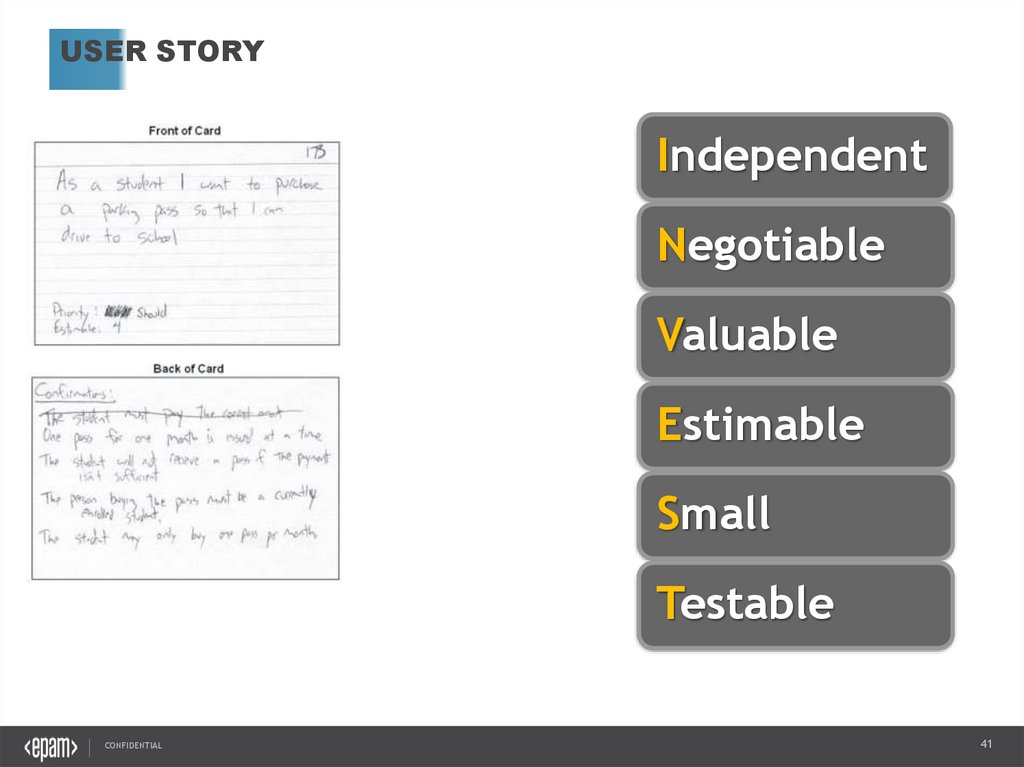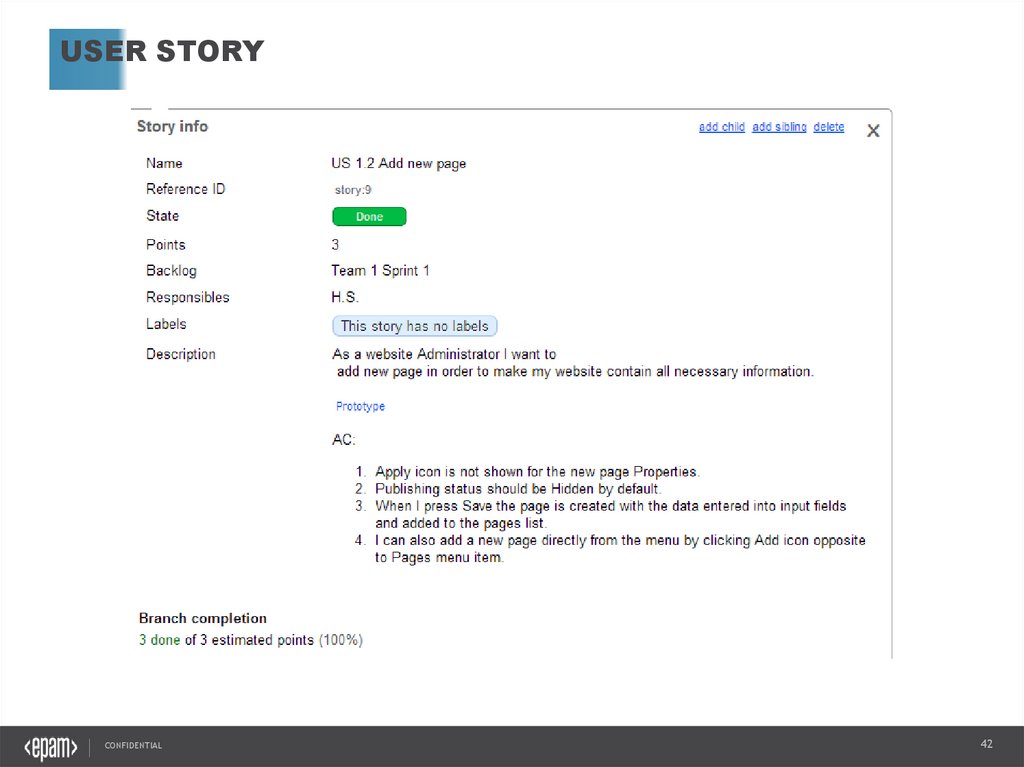Similar presentations:
Requirements analysis
1.
Requirementsanalysis
Zotova Nina
31 April 2016
CONFIDENTIAL
1
2.
THE CUSTOMEREXPLAINED
The analyst
designed
The programmer
made
The customer
wanted
Example
CONFIDENTIAL
2
3.
THE REQUIREMENTRequirement - a specification
of what is to be implemented.
They described the behavior of
the system, the system
properties, or attributes.
CONFIDENTIAL
7
4.
WHAT ARE THE REQUIREMENTS?CONFIDENTIAL
8
5.
FUNCTIONAL REQUIREMENTS• Determine the functionality of the software , which the
developers must implement to allow users to perform required
tasks
• Answer to the question:
What should a developer DO ?
• Source - analysts, developers , the UI Designer , Usability
Engineer
• Example:
– Добавить в отчет новое поле «E-mail исполнителя», с
форматом текста Times New Roman, шрифт 10
CONFIDENTIAL
11
6.
QUALITY ATTRIBUTES• Often referred to as “non-functional requirements»
• Additional description of the product and \ or characteristics
that are important for the product developers or users
• Example:
– Максимальное использование парадигмы интерфейса MS
Office – продвинутый пользователь MS Office после 15минутного тренинга должен быть способен вызывать
любые функции программы
CONFIDENTIAL
12
7.
INSTEAD OF SUMMARYCONFIDENTIAL
17
8.
FEATURES SUPERIOR REQUIREMENTSCONFIDENTIAL
Complete
Correct
Ambiguous
Consistent
Verifiable
Prioritization
18
9.
COMPLETE• Each request must contain all the necessary
information to the developer to ensure that
design and implement the required functionality
correctly
• Ideally, the requirement describes :
–What need to do?
–How does it look like?
–How does it behave?
CONFIDENTIAL
19
10.
WHAT NEED TO DOFR-WUI-005
Просмотр баланса
[DCB] и [DCB] E
«Реализовать функцию
просмотра баланса Заказчика
самим Заказчиком или сервисинженером, причем сервис
инженер имеет возможность
просмотреть баланс любого
Заказчика»
CONFIDENTIAL
20
20
11.
HOW DOES IT LOOK LIKEБыстрый заказ
История заказов
Баланс клиента Запросить отгрузку
Поиск клиента
Баланс клиента
CUSTOMER_NAME (CUSTOMER) (название организации хранится в сессии, Debtor ID (CUSTOMER) возвращается функцией)
за
июнь
2003
г
Обновить
Формирует для запроса DateFrom по DateTo
Баланс клиента: BALANCE
Показать все проводки
Дата
Счет-фактура
DOC_DATE
REF_DOC_NO
DOC_DATE
Текущий клиент: 0000001
Изменить на:
Показать отгрузки
Отгружено
Показать оплаты
Обновить
Оплачено Срок оплаты
AMT_DOCCUR+
BLINE_DATE+DSC
TX_DOC_CUR,
T_DAYS1
CURRENCY
AMT_DOCCUR+TX_
DOC_CUR,
CURRENCY
Найти
Изменить
[DCB] E
Source: FR-WUI-005
CONFIDENTIAL
21
21
12.
HOW DOES IT BEHAVEPrimary Actor: Инженер (пользователь)
Precondition: Инженер (пользователь) прошел авторизацию в системе, получил
доступ к базовой странице [NAV] и выбрал пункт.
Success guarantee: На экране отображена страница с соответствующей
информацией.
–
Main success scenario:
1.
Система отображает страницу Баланс Заказчика [DCB]. По умолчанию в полях
выбора даты указывается текущий месяц и год, а на самой странице
отображается информация о всех проводках Заказчика за текущий месяц.
2.
Инженер (пользователь) изменяет значения, заданные в полях выбора даты, и
нажимает кнопку Обновить. Система выводит информацию о проводках
Заказчика за указанный месяц.
Или:
3.
Инженер (пользователь) задает, какую именно информацию он хочет увидеть
– установив переключатель Показать все проводки, Показать отгрузки,
Показать оплаты - и нажимает кнопку Обновить. Система выводит
информацию требуемого типа за указанный месяц.
Extensions:
Во всех случаях, когда система обращается к коннектору, а он оказывается
недоступным, отображается страница Баланс Заказчика с информацией об ошибке
Ошибка доступа к системе.
Инженер может изменить текущего Заказчика, введя его номер в
соответствующее поле и нажав кнопку Изменить. Для поиска номера Заказчика
можно воспользоваться кнопкой Найти [DCS] Customer Search.
CONFIDENTIAL
22
22
13.
COMPLETE: TYPICAL PROBLEMSComplete
All significant requirements are
included.
No items have been left
for future definition.
Often:
• Non Functional requirements missing
• Hidden assumptions
• Too general statements
Examples:
“Application V.2 should be 50% faster”
Each operation? Maximum time? What is current performance?
“Application will be localization ready’”
Customer assumes: we will just provide file with resources
CONFIDENTIAL
23
14.
CORRECTEach requirement must accurately describe the desired
functionality
• Aspect One: Interpretation
– Make sure that the user understanding and the same
developer
• Aspect Two: Consistency
– There should be no conflict , duplicate or conflicting
requirements
CONFIDENTIAL
24
15.
WHEN WE VERBALLY DISCUSS IDEAS, WEMAY
INCORRECTLY BELIEVE WE HAVE THE SAME
UNDERSTANDING
CONFIDENTIAL
25
16.
REPRESENTING OUR IDEAS ALLOWSUS TO DETECT INCONSISTENCIES
CONFIDENTIAL
26
17.
CORRECT: TYPICAL PROBLEMSCorrect
Every stated requirement represents
Something required of the system
to be built.
Usual problems:
• Incorrect statements (Copy-Paste, Mistypes)
• Obsolete requirements
• Gold plating – features that add cost, but not much value
• Technically impossible features
• Design mixed into requirements
CONFIDENTIAL
27
18.
AMBIGUOUS• The ability to interpret the same requirement of
different
• Several readers have several different
understandings of what needs to be done to
implement this requirement
CONFIDENTIAL
28
19.
AMBIGUOUS : TYPICAL PROBLEMSAmbiguous
Every statement has one interpretation.
Terms are clear and well defined.
Example:
“The feature XYZ is optional”
Designer: “The feature is optional, we do not have to implement
this”.
Customer: “Wow, the product will have nice XYZ feature”.
Marketing: “The feature is optional, so we’ll provide it as
additional package for extra money”.
CONFIDENTIAL
29
20.
EXAMPLEData Input
1-2h
CONFIDENTIAL
3-5h
30
21.
WORDS THAT SHOULD RAISE SUSPICION:easy
provide for
as a minimum
be capable of
effective
timely
as applicable
if possible
TBD
as appropriate
if practical
at a minimum
but not limited to
capability of
efficient
CONFIDENTIAL
capability to
normal
minimize
maximize
optimize
rapid
user-friendly
simple
often
usual
large
flexible
robust
state-of-the-art
improved
32
22.
CONSISTENTConsistent
Conflicting terminology, contradictory required
Actions and impossible combinations
are notably absent
Example:
“For Customers, who are exempted from receiving billing
reminder notices, ensure that two notices are generated”.
It is inconsistent: you don’t generate reminders for exempted
customers.
CONFIDENTIAL
33
23.
VERIFIABLEExamples:
“Application will have 0 bugs.”
“Application will be user friendly.”
CONFIDENTIAL
34
24.
REQUIREMENTS: TYPICAL PROBLEMSInconsistent
Incomplete
Not verifiable
Incorrect
Ambiguous
CONFIDENTIAL
35
25.
PRIORITIZATION• Not on the principle of separation " is important , it
does not matter ," and ordering on the principle of
"first - second-third ”
– Each request is mapped version of the application (
iteration of development) , in which it should appear
– The sponsor and the users should be aware that the
priorities only describe what is being done first , and
then what , not what will be done and what is not
CONFIDENTIAL
36
36
26.
WHAT IS REQUIREMENTS IN AGILE?CONFIDENTIAL
37
27.
PRODUCT BACKLOGCONFIDENTIAL
38
28.
PRODUCT BACKLOG• Master list of all
“features”
• High priority
features are split
into “stories”
achievable within
an iteration.
• Each “story” is
prioritized and
scoped.
CONFIDENTIAL
39
29.
PRODUCT BACKLOGCONFIDENTIAL
40
30.
USER STORYIndependent
Negotiable
Valuable
Estimable
Small
Testable
CONFIDENTIAL
41
31.
USER STORYCONFIDENTIAL
42
32.
CLARIFYING REQUIREMENTS – OPTION 1: GROOMINGWhen
Before a sprint, even 1 week before
Input
User Stories created and described by PO
Who participates
What testers do
before grooming
On grooming
CONFIDENTIAL
All team, dev and test, PO
Analyze user stories from the point of:
• What information is missing and will prevent us from
testing?
• What is strange /not logical/contradicts other reqs?
• Do I know how to test this?
• What is missing to test this? ( e.g. data )
Ask questions by user stories
Clarify PO answers
Plan if needed additional discussions (e.g. with
architecture)
43
33.
CLARIFYING REQUIREMENTS OPTION 2 - 3 AMIGOS SESSIONS3 amigos are
• Business Analysis or Product Owner -What problem are we trying to
solve?
• Developer(s) -How might we build a solution to solve that problem?
• Tester(s) -What about this, what could possibly happen?
3 amigo sessions are conducted to discuss user stories, questions by user
stories
CONFIDENTIAL
44
34.
WHAT CAN GO WRONG?What can happen?
• Not enough stories exist/have details in the backlog
before grooming
• PO does not know what the purpose of the story or
details
• PO is not ready to answer on questions
What can we do?
• Plan grooming in advance
• Prepare and share questions with PO before session
• Push to “move out of sprint” not clear stories on plann
• PO does not come on grooming
• Plan grooming in advance
• Prepare and share questions with PO before session
• Team works with several POs and they contradict
each other
• PO changes opinion a bit later
• Requirements are changed on the fly
• Store PO’s answers in common source
• Have answers recorded; measure and
communicated impact of changes
CONFIDENTIAL
45
35.
ACCEPTANCE CRITERIACONFIDENTIAL
46
36.
WHAT ARE ACCEPTANCE CRITERIA?• Acceptance Criteria are the conditions that a software
product must satisfy to be accepted by a user, customer, or
in the case of system level functionality, the consuming
system
• Acceptance Criteria are a set of statements, each with a
clear pass/fail result, that specify both functional and nonfunctional requirements, and are applicable at the Epic,
Feature, and Story Level. Acceptance criteria constitute
our “Definition of Done”, and by done I mean well done.
CONFIDENTIAL
47
37.
ACCEPTANCE CRITERIA FORMATThe Given/When/Then format is helpful way to specify
criteria:
Given some precondition
When I do some action
Then I expect some result
CONFIDENTIAL
48
38.
HOW CAN ACCEPTANCE CRITERIA BE USED FOR TESTINGAll acceptance criteria must be checked during testing
Besides them tester also should think about
• All possible negative verifications
• Functional verifications for controls
• UI check
• Integration this functionality with the system
• End-to-end scenario
• …
Acceptance criteria is a start for testing, but not all what can
we should verify!
CONFIDENTIAL
49
39.
ART ASK QUESTIONSCONFIDENTIAL
50
40.
QUESTION: WAY TO ANSWERRequirements or Google
More experienced tester
Developer
Customer
CONFIDENTIAL
51
41.
WHEN THE RESPONSE IS SUFFICIENT ?• Specific answer
• No “may be”, “I
think”
• No contradictions
• You are 100% sure
• You understand “why”
CONFIDENTIAL
52
42.
NO ANSWER?• Remind by email
• No answer in a week- escalate his
manager
CONFIDENTIAL
53
43.
ASKING QUESTIONS REQUIRES COURAGEMany people do not ask questions
because they are afraid
CONFIDENTIAL
54
44.
ASKING RIGHT QUESTIONS REQUIRESTHINKING AND SKILL
There is a lot of mental work
between “I do not
understand” and the right
question
CONFIDENTIAL
55
45.
TO ASK A QUESTION, YOU NEEDTO NOTICE THE PROBLEM FIRST
CONFIDENTIAL
56
46.
SHOULD WE CLARIFY FIELDSLENGTH, VALIDATION?
Absolutely yes for client facing cites
Things to clarify
– Unique( +case sensitive)
– Required
– Min, Max
– Allowed symbols
– Languages
– Default values
– Messages texts
CONFIDENTIAL
57
47.
First you work for your reputation, thenyour reputation starts working for you
CONFIDENTIAL
58
48.
SEEING GENERAL PICTURECONFIDENTIAL
59
49.
THE CLASSIC CONTEXT-FREEQUESTIONS
The traditional newspaper reporters’ questions are:
– Who
– What
– When
– Where
– How
– Why
For example, Who will use this feature? What does this user
want to do with it? Who else will use it? Why? Who will choose
not to use it? What do they lose? What else does this user want
to do in conjunction with this feature? Who is not allowed to
use this product or feature, why, and what security is in place
to prevent them?
CONFIDENTIAL
60
50.
SEEING GENERAL PICTURE• To ask a question
of standing , it is
necessary to go
beyond the
requirements of
• To see the image
as a whole ( a
piece of the
puzzle does not fit
)
CONFIDENTIAL
61
51.
Всем спасибо за внимание!CONFIDENTIAL
67



















































 management
management








